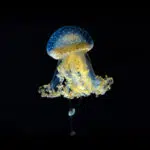Let’s see a show of tentacles for all those who love jellyfish — Jellyfish Day on November 3 is just for you! It is a day to celebrate that beautiful and mysterious invertebrate the world calls a ‘jellyfish.’ Along with enjoying all this lovely not-really-a-fish sea creature has to offer, the day also encourages people to learn more about this marine animal and then share it with the world.
History of Jellyfish Day
Jellyfish — a class of marine invertebrate animals — have been around for a seriously long time, even longer than dinosaurs. Scientists always believed jellyfish originated some 500 million years ago, a theory proven right with the 2007 discovery of perfectly preserved 505-million-year-old jellyfish fossils in Utah, U.S. This find was particularly mind-boggling because jellyfish, having no bones to speak of, rarely leave a trace of their existence like other animals do.
Jellyfish have always boggled minds, particularly with their distinctive structures. Their mostly transparent bodies, wiry tentacles, and lack of bodily organs confounded early scientists so much that they couldn’t even classify these guys — back when categories were only plants, animals, and humans. Jellyfish weren’t plants but they didn’t fit the specified mold of animals either. The world simply dubbed (classified) them as ‘incomplete’ and didn’t bother investigating further, at least until the microscope was invented. Many such ‘incomplete’ organisms didn’t neatly fit into any category naturalists created, and they were forced to reexamine their categories and come up with new definitions for each.
However, it wasn’t until Charles Darwin proposed his theory of evolution in 1859 — “all living things show a variation in physical traits over time as a process of natural selection” — that the jellyfish got some recognition. Then, the German zoologist and naturalist Ernst Haeckel wrote a book, “Generelle Morphologie der Organismen,” in 1866, which translated to “General Morphology of Organisms.” In it, he illustrated the evolution of many organisms — jellyfish included — to show how primitive animal forms gradually came to be the versions we all know now. He theorized that jellyfish had split from the rest of the organisms at an earlier date — the reason they look so different from other species.
The world began researching the species and has never looked back. In the process, we are also reevaluating the use of ‘fish’ in the ‘jellyfish’ name. ‘Fish’ commonly refers to animals with a backbone and scientists now sometimes call them ‘jellies’ too. Today, this (somewhat) invasive species has survived and thrived almost all over the world because they need very little oxygen. They can survive in any water, enjoy a broad diet, reproduce very quickly, and shrink when food reserves reduce, only to revive themselves when food is available again.
Jellyfish Day timeline
NASA sends 2,478 jellyfish into space as part of a first-of-its-kind experiment; by the end of the experiment, the jellyfish have successfully reproduced and now number almost 60,000.
A nuclear power plant in California temporarily shuts down after the outside water — which it uses to cool down its reactor cores — includes a large number of jellyfish, which clog the system.
Researchers from Virginia Tech create an aquatic robot modeled on the jellyfish’s structure, and design, which they hope can be used to study the mystery of the sea.
A study on jellyfish shows the world that the brain is not required to experience sleep; the jellyfish enters a sleep-like state and is sluggish if it does not ‘sleep,’ supporting the theory that a brain is not essential for sleeping.
Jellyfish Day FAQs
Why do they call jellyfish ‘jellyfish?’
These marine animals have been dubbed jellyfish since the 1700s. Their name is a combination of the Latin ‘gelare,’ for ‘congeal’ or stiffen,’ and the Proto-Indo-European ‘pisk’ meaning “a fish, an animal that lives in the water.”
Can jellyfish live forever?
While jellyfish mostly only live for a few months, one species of jellyfish lives forever, kind of. The Turritopsis dohrnii is capable of regenerating to its earliest stage of life — like a human regressing back to babyhood — if it experiences any illness or trauma and then starts the whole life process again.
Can we eat jellyfish?
People across the world have been known to enjoy a diet of jellyfish, especially in Southeast Asia. They can be consumed shredded, thinly sliced, boiled, and more.
Jellyfish Day Activities
Visit an aquarium
Find and visit the jellyfish exhibit at aquariums and zoos near you. Some global aquariums host major events on this day, which you could check out online, if available.
Learn more about jellyfish
These invertebrates have been well-documented in books, documentaries, and television shows over the years. Pick a few you like and settle down to educate yourself about this luminous animal.
Introduce jellyfish to your loved ones
Why enjoy learning about these incredible evolutionary wonders alone? Explore jellyfish across various mediums with your loved ones, and share news about Jellyfish Day with everyone so they can join in the celebrations too.
5 Awesome Facts About Jellyfish
Jellyfish are 95% water
They've got a water-based substance called ‘mesoglea,’ which contains their muscles, nerves, and structural proteins.
Their bodies are called bells
The jellyfish swims around by contracting and relaxing their muscles around the bell.
They are beautiful
They come in a range of colors — pink, red, yellow, purple, blue, or even clear — and nearly half of the entire jellyfish population on Earth glow brightly because of a physical trait called ‘bioluminescence.’
A very venomous jellyfish
A species of jellyfish called the ‘Malo kingi’ or the ‘common kingslayer’ has one of the world's most potent venoms, despite being only the size of a human fingernail.
Jellyfish are harvested for collagen
Collagen from jellyfish is compatible with most cell types and is ideal for multiple medical applications, including treating wounds and helping with rheumatoid arthritis.
Why We Love Jellyfish Day
Jellyfish hold many secrets
Learning about these complex creatures can help us understand our past. This gives us a path to the future.
Every ‘fish’ needs its day to shine
These invertebrates don't always get the love they deserve. A special day to celebrate them seems like the perfect way to introduce more people to jellyfish.
Jellyfish awareness increases sustainable practices
The more we learn about jellyfish, the more we begin to see a way forward that does not harm the planet. Jellyfish are a green and sustainable food source, and their ability to bind to microplastics shows a potential way out of the world's plastic problem.
Jellyfish Day dates
| Year | Date | Day |
|---|---|---|
| 2025 | November 3 | Monday |
| 2026 | November 3 | Tuesday |
| 2027 | November 3 | Wednesday |
| 2028 | November 3 | Friday |
| 2029 | November 3 | Saturday |




















